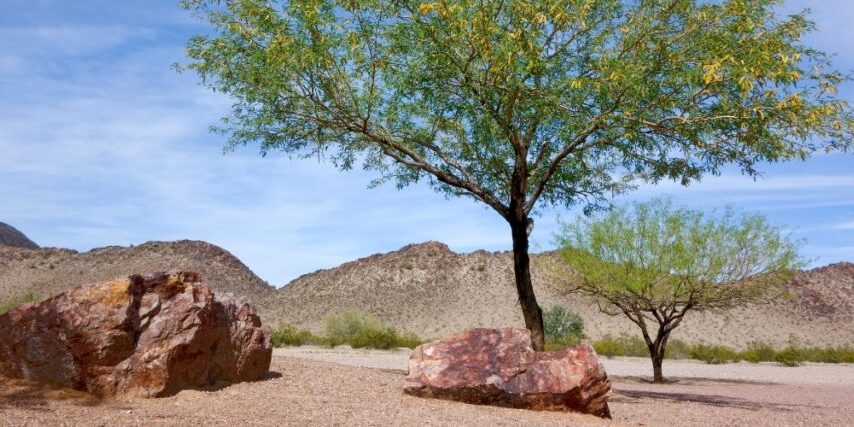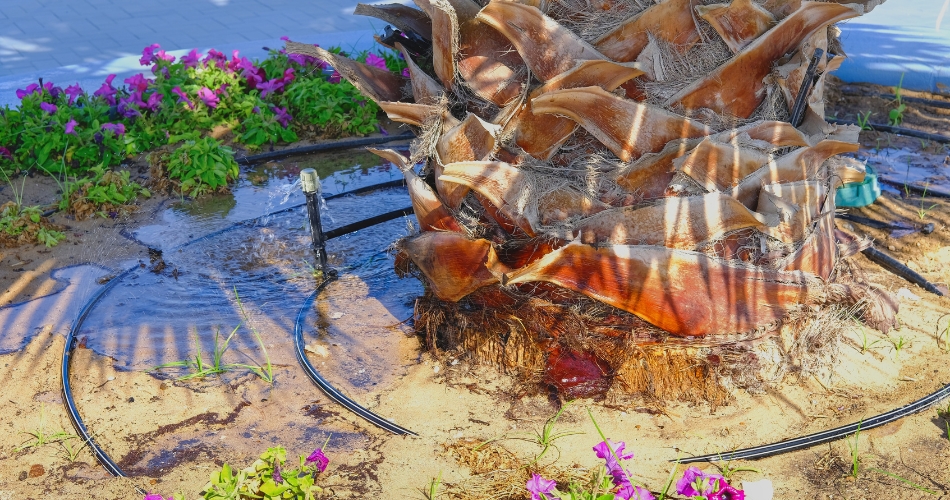
June is that time of year when the scorching sun beats down mercilessly on North Phoenix, turning our desert landscape a little browner every day as we hope for the monsoon rains to arrive early. But what happens when the monsoons don’t come, and we find ourselves in a drought?
While we humans have the luxury of plentiful drinking water, our trees often struggle to survive during drought conditions. But, with a few smart strategies and a little extra TLC, we can keep trees healthy during drought.
Key Takeaways
- Recognize early signs of drought stress in trees so you can act quickly to keep them healthy.
- Learn to water trees efficiently by considering timing, frequency, and tree maturity.
- Tailor your watering efforts based on tree characteristics and environmental factors.
- Use water conservation methods like mulching and efficient irrigation systems to protect trees from the worst effects of drought.
- Avoid placing additional stress on your trees to help maintain their health during drought conditions in the harsh desert climate.
Recognize Drought Stress in Trees
Although trees can be tough to care for in the low desert’s arid climate, they bring amazing benefits. Their shade keeps our energy bills down and our homes cooler. They also beautify our neighborhoods, filter pollutants from the air, and even increase property values.
For these reasons and many others, we must keep an eye out for early signs of drought stress in trees to ensure they continue to provide these benefits for many years to come.
Signs of Drought Stress
Here are some signs that indicate your tree is suffering from drought stress:
- Wilting Leaves: Imagine yourself feeling parched on a hot day. It makes you feel limp, sluggish, and desperate for a drink. Like you, those wilting leaves are typically the first sign that your tree is dehydrated and needs water.
- Browning Leaf Edges: When a tree is dehydrated, it can’t keep up with the water it loses through its leaves. The part of the tree that is most vulnerable are the tip and edges of the leaves because they are furthest from the water in the soil that the roots absorb. The lack of moisture causes the tips of the leaves to dry out first, turning brown and crispy. Sun-exposed leaves lose water even faster, so they’re often the first to show signs of browning.
- Early Fall Colors: The scorching sun can be especially damaging to trees that are already stressed from lack of water. Leaves may develop brown, scorched patches and fall prematurely, creating a thinner canopy even before the fall season arrives.
- Fewer Flowers or Fruits: When water is scarce, a tree’s priority is survival rather than reproduction. You may notice a decrease in the number of flowers or fruits produced during a drought.
- Thinning Canopy: In a last-ditch effort to save water, your tree will drop its leaves. This creates a thinner canopy, which means less shade for the tree itself. With less shade, more sunlight reaches the whole tree, making it even more stressed and vulnerable to the sun.

A healthy palm tree thrives in a North Phoenix yard thanks to drip irrigation tubes around its base, delivering essential water to its roots.
How to Water Trees During a Drought
Every drop of water counts – especially during a drought. Watering wisely doesn’t mean depriving your trees, but rather using water strategically to ensure it reaches the roots where it’s needed most. This avoids wasting water on evaporation or shallow areas where it won’t benefit the tree.
By implementing the following smart watering techniques, we can help our trees thrive without putting a strain on our precious water resources.
Choose the Right Time of Day to Water
When it comes to watering efficiently, one of the most important things to remember is the time of day you turn the water on. The harsh desert sun can quickly evaporate water sprayed on trees during the day.
Instead, aim to water early in the morning (before sunrise) or in the evening (after sunset) when temperatures are cooler, and the water can soak into the ground and reach the roots.
Water Mature Trees Thoroughly and Less Frequently
Mature, established trees have developed deep root systems that can access moisture stored deeper in the soil. For these trees, the goal is to water less frequently and for longer periods of time.
Frequent, shallow watering encourages roots to grow closer to the surface, making them more susceptible to drying out during hot, dry periods. A good rule of thumb is to water slowly until the water begins to run off slightly beyond the outer edge of the tree’s canopy.
Young or Newly Planted Trees Need Water More Often
The rule of deep and infrequent watering applies primarily to mature trees with established root systems. However, young or newly planted trees are a different story. These young trees are like energetic kids – they’re putting all their effort into growing quickly!
To keep up with their rapid growth, young trees need frequent watering to help develop a deep, extensive root system that doesn’t dry out at the first sign of heat. Without sufficient moisture, a tree’s growth can be stunted, or even worse, it will die.
How Much Water Your Trees Really Need
Unfortunately, there isn’t a standard water amount that applies to all your trees. Several factors determine how much (or how little) water your tree needs to thrive. Be sure you consider your tree’s water needs in conjunction with the factors below when deciding how much irrigation to provide.
These Factors Affect How Much Water is Needed
- Tree Size: Larger trees with more extensive foliage will naturally require more water than smaller trees.
- Tree Species: Some tree species are more drought-tolerant than others. For example, native trees that have adapted to our dry climate are a great option as they need less water, even during droughts.
- Soil Conditions: Most of the North Phoenix area has heavy clay soil. While clay can retain moisture well, it can also be slow to drain. This means frequent, shallow watering can lead to water pooling on the surface and failing to reach the roots.
- Sun Exposure: Trees planted in full sun require more water than those in partial shade or filtered sunlight. The desert sun tends to dry things out rather quickly, so trees that see over eight hours of sun a day need more water to compensate for the increased evaporation.
How to Tell If Your Trees Are Getting Enough Water
An excellent way to tell if your tree is getting enough water is to check the moisture level in the soil around the base of the tree. The drip line, or the imaginary circle created by the
outermost branches of your tree, is where you should focus your water efforts since this is where most of the tree’s roots are.
About an hour after watering, try pushing a soil probe into the soil. It will slide effortlessly through wet soil but is nearly impossible to push through dry soil. Trees should be watered to a depth of at least 3 feet.

Colorful and healthy plants and trees flourish in a water-wise xeriscaped yard.
How to Conserve Water While Keeping Drought-Stressed Trees Alive
Water is a limited resource, especially during a drought. When drought conditions persist, cities like Phoenix may issue water alerts or implement restrictions as part of their drought management plan. This doesn’t mean your trees have to suffer! Here are some strategies that can help keep your trees healthy during drought conditions:
Apply Mulch
Correctly applying a thick layer of mulch around the base of your trees helps significantly reduce water evaporation from the soil surface. This helps the soil retain moisture, allowing your tree to have access to water for longer periods of time.
Upgrade Your Irrigation System
Traditional sprinklers can waste a lot of water through evaporation and overspray. Instead, consider upgrading to one of these more efficient watering options:
- Drip Irrigation Systems: These systems deliver water directly to the root zone of your trees through a network of tubes and emitters. This minimizes water loss and ensures water reaches the parts of the tree that need it most.
- Smart Irrigation Systems: These high-tech systems use sensors to monitor soil moisture and automatically adjust watering schedules based on real-time weather conditions.
Harvest Rainwater
Here in North Phoenix, every drop of rain counts! During the occasional downpour, our gutters channel rainwater away from our homes. But what if we could capture this instead of letting it flow down the drain? Rainwater harvesting involves collecting rainwater runoff from your roof in a container, like a cistern or a barrel. You can then use the collected rainwater to water your trees and other landscaping.
Additional Tips for Keeping Trees Healthy During a Drought
Watering wisely is the foundation for keeping your trees healthy during a drought, but it’s not the only puzzle piece. Trees face a variety of challenges beyond just dehydration in the Sonoran Desert. During a drought, trees are more susceptible to pests, diseases, and even physical damage.
Other things you can do to ensure your desert trees remain healthy include:
Avoid Excessive Pruning
While proper pruning can benefit trees by removing dead or diseased branches, excessive pruning puts a lot of unnecessary stress on the tree and creates open wounds that allow pests in. Pruning adds more stress an already drought-stressed tree and is a recipe for disaster.
Minimize Soil Compaction
Xeriscaping is a very popular water-saving approach for desert landscapes. However, excessive use of rocks, pavement, and patios not only traps heat in the soil, but these materials also contribute to soil compaction. Compacted soil restricts air and water flow to the roots, making it difficult for the tree to take up the moisture it needs.
Monitor for Other Signs of Stress
While drought is a common culprit of tree stress, desert trees can become stressed due to other factors such as pests, diseases, and even changes in their environment. Take some time each week to inspect your trees for unusual leaf discoloration, holes in leaves, or the presence of insects. If you spot a problem, contact your local certified arborist to prevent the issue from worsening.
Beyond the Drought: Partner with Titan Tree Care for Year-Round Tree Health
With these tips, you can protect your tress from heat stress, and give them the best chance of survival during a drought. However, their well-being doesn’t stop there. Just like any living thing, trees need year-round care to thrive.
For expert guidance tailored to your specific needs and our unique desert climate, look no further than Titan Tree Care. As the go-to experts in North Phoenix tree service, you can be confident you’re getting a team with the knowledge and experience to create a personalized care plan for your trees.
From routine pruning and proactive pest and disease management to selecting the best trees for North Phoenix landscapes, Titan Tree Care offers a comprehensive range of services to keep your trees healthy.
Ready to protect your trees? Call us today at 623-444-8448 or complete a form online to request a free estimate.
More Articles Like This

Titan Tree Care is a full-service tree care company located in Anthem, AZ and serving all of North Phoenix. We offer a wide range of services to meet your tree care needs, including tree and palm trimming, tree pruning, tree removal, stump grinding, and more. We also offer insect or disease treatments and fertilization services. We are dedicated to providing high-quality, safe, and effective tree care services to our customers and work hard to ensure that your trees are healthy and look their best.







